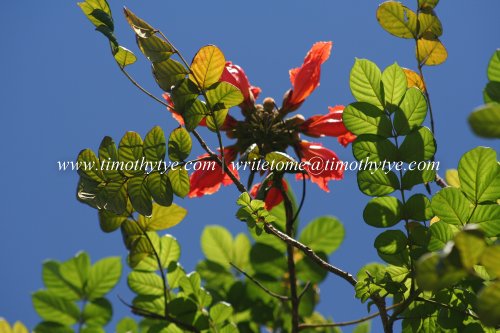African Tulip Tree (Spathodea campanulata)

Flower of the African Tulip Tree (8 April 2009)
© Timothy Tye

Flower of the African Tulip Tree (8 April 2009)
© Timothy Tye
African Tulip Tree (8 April 2009)
© Timothy Tye
The African Tulip Tree is a showy evergreen tree. Known by the scientific name Spathodea, the African Tulip Tree is a monotypic genus in the flowering plant family Bignoniaceae. There is only one species, Spathodea campanulata, also known as the Fountain Tree, "African tulip tree", Flame-of-the-forest or Nandi Flame. It can grow to between 7 - 25 metres (23 - 82 ft) tall, and is native to tropical Africa. This tree is planted extensively as an ornamental tree throughout the tropics and is much appreciated for its very showy reddish-orange or crimson (rarely yellow), campanulate flowers.
The flower bud is ampule-shaped and contains water. These buds are often used by children who play with its ability to squirt the water. The sap sometimes stains yellow on fingers and clothes. The open flowers are cup-shaped and holds rain and dew, making them attractive to many species of birds. In Neotropical gardens and parks, their nectar is popular with many hummingbirds, such as the Black-throated Mango (Anthracothorax nigricollis), the Black Jacobin (Florisuga fusca), or the Gilded Hummingbird (Hylocharis chrysura)[1]. The wood of the tree is soft and is used for nesting by many hole-building birds such as barbets.
The generic name comes from the Ancient Greek word spathe, in reference to the spadix-like calyx.
Content Attribution
 Index of 690
Plants in The Flowering Garden
Index of 690
Plants in The Flowering Garden
Copyright © 2008-2018 The Flowering Garden. All Rights Reserved.